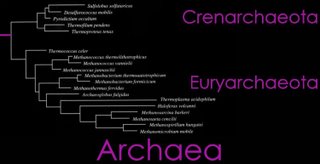The
Archaea (formerly
Archaeobacteria, or
Mendosicutes) constitute a recently recognized
phylogenetic domain. While
Eubacteria and Archaea are similar in structure, they have a different metabolism and genotype. A defining physiological characteristic of Archaea is their ability to live in extreme environments. Thus, these organisms are called “extremophiles” and, unlike Eubacteria and Eukarya, they depend for survival on environmental conditions such as high salinity, extremes of temperature, unusual chemical substrates, or high pressure.
Archaea can be distinguished from bacteria in that their
cell walls do
not have murein—a peptidoglycan-containing muramic acid. Their
plasma membranes are ~4-5 nm in thickness, and are unique in including
isopranyl ether lipids – branched isoprenoid hydrocarbons that are linked to glycerol by di-/tetraether bonds. The glycerol diethers are associated with bilayer membranes, whereas the glycerol tetraethers are associated with monolayer membranes. Archaea with mixtures of di- & tetraethers have mixed mono- & bilayer- membranes. Hyperthermophiles have increased membrane fluidity due to branched glycerol tetraethers, and often lack a cell wall. Psychrophiles have lipids comprising mainly unsaturated fatty acids. The plasma membrane of Archaea also contains
sulfolipids.
The
cell walls of most Archaea comprise a multilayered sacculus (sheet) that surrounds the plasma membrane and provides resistance to osmotic shock. This enables the Archaea (except
Thermoplasma) to maintain high intracellular osmotic pressures (15-20 atm). The cells wall may comprise peptidoglycans (
Methanobacterium) in which the chief sugars are N-acetyl talosaminouronic acid (
NAT or T) and GlcNAc (
NAG or G). These are linked to each other by lysozime insensitive (b1->3) glycosidic bond. The T units are linked to L-aminoacid containing oligopeptides by a penicillin-insensitive
transpeptidase. In other genera, the cell wall may comprise only non-sulfated polysaccharides (
Methanosarcina), only sulfated polysaccharides (
Halococcus), only proteins (
Methanomicrobium and
Methanococcus), or negatively charged aminoacid-containing peptides (
Halobacteria).
Images:
tem -thermophilic archaeobacteria,
line-up
Phylogenetic taxonomy of the Archaea (right), based on 16s rRNA trees.
The Bacteria (
eubacteria) were the first prokaryotes recognized. (see
phylogeny)
In 1977, Woese and Fox discovered the Archaea based upon their phylogenetic relationships to the Bacteria and the Eucarya. The yellow asterisk indicates the progenote, and the junction between teal and purple lines, the Last Common Ancestor, or Cenancestor.
Woese, Free Full Text Article:
Toward a natural system of organisms
(left) The Domain Archaea is divided into three Phyla: Crenarchaeota, Euryarchaeota, and Nanoarchaeota. A brief phylogenetic relationship of Crenarchaeota and Euryarchaeota are shown in the tree diagram (top right), and a more detailed cladogram is shown below. (click to enlarge)
From the
Taxonomicon, based on Systema Naturae, 2000:
Domain Archaea (Woese, Kandler & Wheelis, 1990)
Phylum CrenarchaeotaClass Thermoprotei
Order Thermoproteales™ Zillig & Stetter, 1982Order DesulfurococcalesOrder Sulfolobales Stetter, 1989Phylum Euryarchaeota
(Woese, Kandler & Wheelis, 1990)
Class MethanobacteriaClass MethanococciClass HalobacteriaClass ThermoplasmataClass ThermococciClass Archaeoglobi Garrity & Holt, 2002Class MethanopyriPhylum Nanoarchaeota
Huber et al., 2002
Genus Nanoarchaeum™ Huber et al., 2002The Archaea: A Personal Overview of the Formative Years: "The simple method of growing methanogenic cells in an anaerobic pressurized atmosphere of hydrogen and carbon dioxide was pivotal to the discovery of the Archaea, for hydrogen and carbon dioxide could be replenished with safe containment of high levels of 32P and without exposure of cells to oxygen or contamination.
In November 1977, Woese and Fox proposed that ribosomal RNA sequence characterization could be used to define three "aboriginal lines of descent" (
Woese and Fox, 1977). One line, the typical bacteria, was designated "eubacteria." "archaebacteria" was proposed as a name for the methanogen line, and the term "urkaryotes" was proposed for the cytoplasmic component of eukaryotic cells. So the methanogens were Archaebacteria. The name Archaebacteria was suggested by David Nanney. In a way, the term was unfortunate because the case was being made that the methanogens were "old" (i.e., represented a very ancient divergence in evolution), so that they were no more related to bacteria than to eukaryotes. On the other hand, they were bacteria. (Over a decade later, Woese, Kandler, and Wheelis would propose the name "Archaea" for the Archaebacteria [
Woese et al., 1990]. By that time, much evidence had accumulated showing the Archaea clearly belonged on the eukaryotic line of descent, and it would be less confusing if the word "bacteria" in Archaebacteria was deleted.)"
more detail:
Physiology of the Archaea :
Free Full Text Article :
Phylogenetic structure of the prokaryotic domain: The primary kingdoms. Woese CR,
Fox GE.
Proc Natl Acad Sci U S A. 1977 Nov;74(11):5088-90.
1995 Commentary
Archaea: narrowing the gap between prokaryotes and eukaryotes pdf
Information on Archaea:
Information on
Archaea from the American Society for Microbiology
An Introduction to Archaea from the Department of Plant Biology at University of California, Berkeley
USGS
Microbiology Laboratory, Columbus, Ohio
USGS
Microbiology Research: Activity, Biogeochemistry, and Transport in Water
U.S. Environmental Protection Agency's Microbiology Home PageU.S. Department of Energy's
Microbial Genome ProgramArchaea Taxonomy from the National Institutes of Health
News:
A hydrogen-based subsurface microbial community dominated by methanogens: Nature
Scientist May Have Discovered a Model for Extraterrestrial Life, Washington Post
Found: Life on Earth That Could Exist on Mars, New York Times (by Associated Press)
Scientists Find New Kind of Microbe, New York Times (by Associated Press)
UMass Researchers Find Environment on Earth that Mimics Mars Geochemically and Supports Ancient Life Form, NASA Press Release
Labels: Archaea, Archaeobacteria, cell walls, extremophiles, isopranyl ether lipids, Mendosicutes, NAG, NAT, phylogenetic taxonomy, sulfolipids
 The two prokaryotic domains are Eubacteria (bacteria) and Archaea. The Eubacteria are usually called the Bacteria, and the Archaea are sometimes called the Archaebacteria.
The two prokaryotic domains are Eubacteria (bacteria) and Archaea. The Eubacteria are usually called the Bacteria, and the Archaea are sometimes called the Archaebacteria.








































